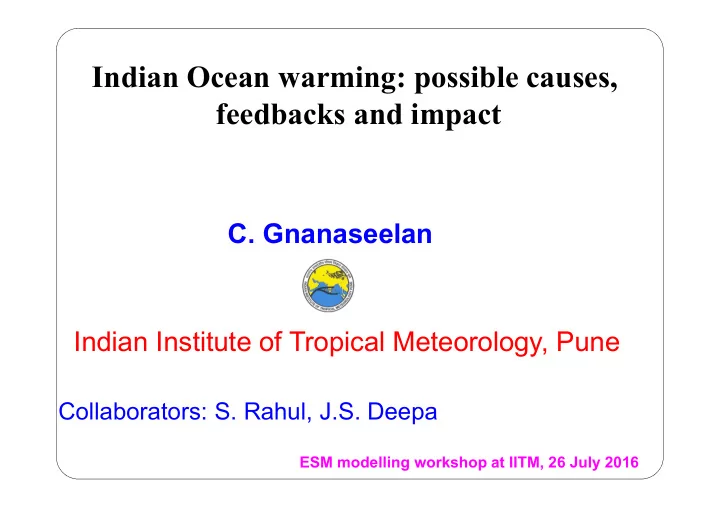

Indian Ocean warming: possible causes, feedbacks and impact C. Gnanaseelan Indian Institute of Tropical Meteorology, Pune Collaborators: S. Rahul, J.S. Deepa ESM modelling workshop at IITM, 26 July 2016
OUTLINE Possible mechanisms for Indian Ocean warming Role of surface circulation changes and its coupled feedback on Indian Ocean warming Indian Ocean response to the recent global warming hiatus Role of Indonesian Throughflow on the Indian Ocean warming Meridional Overturning circulation on accelerating Indian Ocean warming
1958 to 2008 (in o C/decade)
(in o C/decade)
Heat flux trends (W/m 2 /year) Large bias in heat flux products but they all agree in the negative heat flux trends Net heat flux (W/m 2 ) Rahul & Gnanaseelan, 2013, GSRL
MOM5 experiments Cooling in the western IO due to changing ocean dynamics is overcome by positive net heat flux Trends in the model wind stress Annual mean net heat flux in model
TRENDS IN CURRENTS per decade SODA ORAS4 1958 to 2008 1958 to 2015 Courtesy: Rashmi Gnanaseelan et al. (2016)
Trends in annual SST and winds Rahul & Gnanaseelan, o C per decade 2015, CD
Annual mean southeasterly trade in south IO and westerlies at equator induces a cyclonic curl in SWIO which manifests a unique open ocean upwelling zone in SWIO (5 o to 15 o S and 50 o to 80 o E) and characterized by Shallow thermocline (Known as thermocline ridge in Indian ocean).
Ocean response (in thermocline depth or SSHA) SODA ORAS4 MOM5 HYCOM SSHA trend for Indian Ocean based on SODA,ORA, and MOM5 (1959-2008) HYCOM SSHA trend for 1961-2008 (Han et.al,2010)
Upwelling in the north Upwelling in the south
Courtesy: Rahul Watterson, 2001
Concides with the global mean surface temperature hiatus Rahul & Gnanaseelan, 2016, Clim Dyn
First EOF of stream function (after applying a 7 year running mean) Model captures these epochal changes …. MOM5 First EOF of velocity potential (after applying a 7 year running mean) Rahul & Gnanaseelan, 2016, Clim Dyn
SODA ORAS4 SST and winds regressed with the first PC of stream Function, and their trends are shown in the right panels
Coupled feedback mechanism
Hiatus anomaly La Nina anomaly comp Ueda et al. 2015, nature comm. 1999 to 2014 Correlation between Nino3.4 index with Indo-Pacific SSTA
North Indian Ocean warming
Global ocean heat content (700m) Pacific Ocean heat content Indian Ocean heat content ITF transport Lee et al. 2015, nature geos.
Vertical structure of temperature trends Model simulated the pattern well, but most of the CMIP coupled models fail to represent the subsurface pattern
Indonesian Through Flow can modulate Indian Ocean temperature
ITF in MOM5 Deepa et al. 2016 Lee et al. 2015
Sea level anomaly trend(mm/year) 1959-2008
Meridional Volume transport across the Equator
Meridional Volume transport across 20 o S
SUMMARY Indian Ocean warming trends can not be explained by net heat flux Recent Indian Ocean warming pattern is not associated with the atmospheric teleconnections, and ocean dynamics plays an important role Changing surface circulation patterns explains the recent IO warming trends to a large extent Cooling in the western IO due to changing ocean dynamics is overcome by positive net heat flux Recent increase in ITF explains subsurface warming trends in the southern TIO The equatorial Indian Ocean forcing affects ITF and then to the subsurface warming in the south
Thank You We need a good model to understand the Indian Ocean warming
Ueda et al. 2015, nature comm Roxy et al. 2015, nature comm
Swapna et al. 2014
Recommend
More recommend